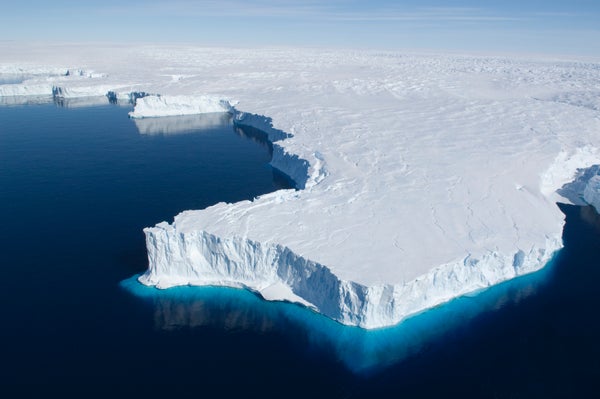Antarctic ice shelves have lost nearly 4 trillion metric tons of ice since the mid-1990s, scientists say. Ocean water is melting them from the bottom up, causing them to lose mass faster than they can refreeze.
That's according to a new study analyzing satellite data from 1994 to 2018. The results were published yesterday in the journal Nature Geoscience.
That spells bad news for the hundreds of glaciers spread out along the Antarctic coastline.
On supporting science journalism
If you're enjoying this article, consider supporting our award-winning journalism by subscribing. By purchasing a subscription you are helping to ensure the future of impactful stories about the discoveries and ideas shaping our world today.
Ice shelves are ledges of ice that jut out from the edge of the continent into the ocean. They help to keep glaciers stable, holding them in place.
As ice shelves melt, they become thinner, weaker and more likely to break. When this happens, they can unleash streams of ice from the glaciers behind them, raising global sea levels.
Scientists have grown more concerned about Antarctic ice shelves in recent years. Research increasingly suggests that ice shelves in certain regions of the continent — particularly in West Antarctica and parts of the Antarctic Peninsula — are melting and thinning from the bottom up.
The new study confirms that the fastest-melting areas are mainly ice shelves jutting into the Amundsen and Bellingshausen seas, which back up to the coast of West Antarctica and the western flank of the Antarctic Peninsula.
Melting ice shelves account for only some of the ice that Antarctica loses in any given year.
Research suggests that the continent is losing billions of tons of ice each year. Some of the mass loss comes from melting ice shelves, and some of it comes from melting on the surface of the ice sheet. A majority of it comes from chunks of ice pouring from glaciers into the sea.
And thinning, weakening ice shelves can speed up that process.
Currents of warm ocean water appear to be the culprit. This warm water originates in the Pacific and Indian oceans, flowing south toward Antarctica.
It's typically a deep-water current. But when it reaches the Antarctic continent, some of it is able to bubble up toward the surface. There, it's able to seep beneath nearby ice shelves and melt the ice from the bottom up.
The new study shows that the melting hasn't been totally consistent over time. The melting appeared to speed up in the late 2000s, before eventually slowing back down again in the 2010s.
That's likely due in part to the influence of El Niño and La Niña patterns in the Pacific Ocean, according to lead study author Susheel Adusumilli, a doctoral student at the Scripps Institution of Oceanography at the University of California, San Diego. These natural climate patterns can cause ocean temperatures to oscillate between warmer and cooler cycles.
Still, many researchers believe that climate change is likely also contributing to the melting ice shelves. Research suggests that climate change may influence certain wind patterns around Antarctica, which can stir up the waters in the Southern Ocean and increase the amount of warm water that wells up to the surface.
Modeling studies suggest this process may become more intense in the coming decades as the Earth continues to warm.
And even when the melt rates are slower than they've been in the past, the ice shelves are still losing mass overall.
If the ice shelves were in a stable, steady state, then they might oscillate back and forth between gaining mass and losing mass, Adusumilli noted.
But for the last 25 years, "there's always mass loss," he said. "It goes from a small amount of mass loss to a large amount of mass loss to a small amount of mass loss again. It never goes from mass gain to mass loss."
Rising sea levels are the biggest concern about ice loss from Antarctic glaciers. But melting ice shelves are worth keeping an eye on for another reason, Adusumilli added.
The influx of meltwater pouring into the sea can alter the ocean in some significant ways.
The cold, fresh water can form a rigid layer on the surface of the ocean. Some researchers believe that this, in turn, could allow deeper, warmer layers of the ocean to grow even warmer.
And when these warm layers well up at the edge of the continent, they could cause the ice shelves to melt even faster.
"People kind of talk about how increased ice shelf melt can lead to more discharge of grounded ice and sea-level rise," Adusumilli said. "But then the immediate influence of ice shelves on the ocean is also very important."
Reprinted from Climatewire with permission from E&E News. E&E provides daily coverage of essential energy and environmental news at www.eenews.net.
